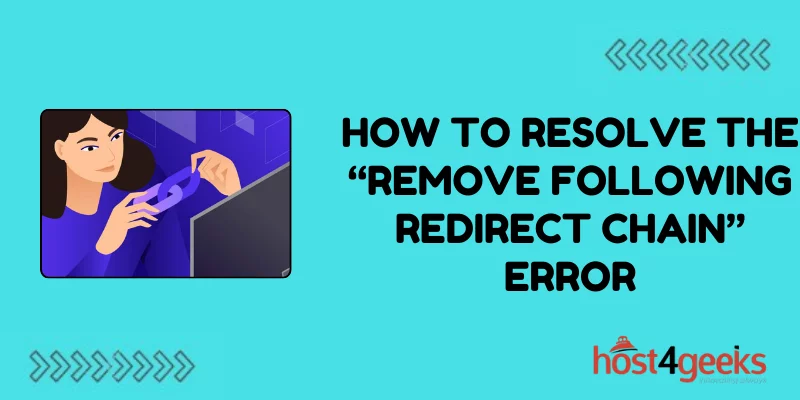Endless redirect loops can frustrate both users and site owners when common “remove redirect chain” errors arise. Website visitors hope to easily access your content, not spin in an infinite cycle of redirects. Fortunately, redirect chains creating this annoying error message can be broken with some redirect analysis and troubleshooting.
In this post, we’ll explore what exactly causes endless redirect chains leading to “remove redirect chain” errors. We’ll also provide actionable solutions to identify and remove problem redirects contributing to chains looping website requests.
By tracing redirects and selectively removing links in those chains causing infinite loops, you can resolve frustrating redirect errors for good. Your visitors will enjoy seamless access rather than receiving messages to remove redirect chains interfering with their site experience.
What is a Redirect Chain Error
A redirect chain error occurs when a series of multiple redirects are created, forming a loop that causes an infinite redirect loop. This prevents users from accessing the final intended page.
This issue typically arises when too many redirects are implemented, often unintentionally. For example, if Page A redirects to Page B, which redirects to Page C, which then redirects back to Page A, it creates a never-ending loop that fails to load any usable content.
The “remove following redirect chain” specifically refers to a redirect loop that needs to be resolved by removing part of the chain.
Identifying the Root Cause of Redirect Chains
Finding the original source of the redirect chain is key. Oftentimes webmasters create redirects to consolidate content or do maintenance, forgetting old redirects that then conflict with new ones.
Analyzing site architecture, content migration efforts, HTACCESS rules, and plugin or CMS settings can uncover where conflicting redirects originate. Narrowing down where the loop begins allows you to break the chain.
Using Site Explorer to Detect Chains
Tools like Moz’s Site Explorer visually map your domain’s redirect chains, making loops clearly evident. The links metric shows individual pages and where they redirect to. Review redirects causing loops or chains spanning over 5 hops.
By visualizing redirect chains, you can identify the unnecessary links creating endless loops and 404 errors. Then remove redundant or conflicting redirects.
Checking CMS Redirect Settings
If your site runs on a CMS like WordPress, redirect plugins or default platform settings may be enabling chained redirects.
Review if plugins like Redirection or Simple 301 Redirects have convoluted redirect rules. Disable problematic plugins or rules and clear browser caches. If native CMS redirects are the culprit, the platform’s documentation can provide steps to simplify redirects.
Correcting Redirects in HTACCESS
The root .htaccess file often contains redirect code that may be chained upon other redirects. Legacy, unused redirects can linger here and interfere with new redirects.
Examine the .htaccess file for unnecessary redirect rules directing to pages further redirecting requests. Delete any outdated redirects to address the bigger chain causing errors.
Consolidating Content Instead
Sometimes redirects form chains when too many redundant pages point users indirect paths. Creating distinct, meaningful paths through site architecture and content fixes this.
Rather than microsites and domains with interlinking redirects, consolidate content onto fewer uniquely purposed domains with clear navigation hierarchies. This prevents endless circles of redirects.
Using 301 Direct Redirects
Straight 301 redirects that directly send users from old pages to new destinations are better than endless chains with multiple hops. Minimize the “redirect chain” by sending users directly where they need to go.
Replace chained redirects with fewer, simpler 301s improving site speed and user experience. Then confirm the direct redirects function as intended using Site Explorer’s redirect tracing.
Removing Looping Redirects
Once you’ve identified specific redirects continuously looping requests, delete those causing the “remove redirect chain” error. If Page A redirects to Page B, which redirects back to Page A, simply removing one of those redirects breaks the loop.
Carefully remove only the portion of the chain looping requests. Preserve other redirects leading users to proper end destinations.
Disabling Problematic Plugins
If a particular plugin or custom code is responsible for adding conflicting redirects, disabling the problem plugin can instantly resolve redirect loops.
Determine which new redirects or plugins precede “remove redirect chain” errors. Temporarily disabling those redirects or plugins can confirm if they are the culprit and should be removed.
Clearing Server-Side Caches
Some redirect chains originate from cached rewrite rules and headers stored server-side. Flushing server caches and restarting the web server erases old redirect chains cached there.
Hosting admin tools provide cache-clearing options. Restart Apache or Nginx to wipe cached redirects on those web server platforms. The browser cache may also require clearing.
Testing Redirect Paths
Before reactivating redirects or plugins, use online redirect checkers to test that previous loops and chains are fully resolved.
Tools like Redirect Detective analyze if traffic flows successfully from old pages to new destinations. Confirm individual working redirects before chaining redirects again.
By searching for and removing the weakest link disrupting the redirect chain, you can resolve those “remove redirect chain” errors hindering site visitors. Consistently test and optimize redirects.
Conclusion
Redirect chains that disrupt site access and trigger “remove redirect chain” errors can be tricky to decipher. However, by methodically tracking down the source of the redirect loop and eliminating the problematic links sending requests in circles, you can resolve even complex redirect issues.
Carefully analyze site plugins, .htaccess rules, hosting configurations, and test redirects before reactivating elements. Confirm that previous chains are fully broken and traffic flows smoothly from old URLs to new destinations.
With some targeted troubleshooting, endless redirect loops can be removed for good. Users will no longer spin fruitlessly in broken redirect chains but rather access site content efficiently. By debugging and optimizing site architecture and redirects, you can avoid frustrating “remove redirect chain” errors going forward.

